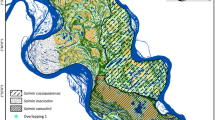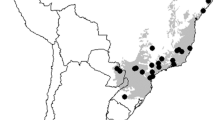Abstract
Assessing the importance of deterministic processes in structuring ecological communities is a central focus of community ecology. Typically, community ecologists study a single taxonomic group, which precludes detection of potentially important biotic interactions between distantly related species, and inherently assumes competition is strongest between closely related species. We examined distribution patterns of vertebrate species across the island of Borneo in Southeast Asia to assess the extent to which inter-specific competition may have shaped ecological communities on the island and whether the intensity of inter-specific competition in present-day communities varies as a function of evolutionary relatedness. We investigated the relative extent of competition within and between species of primates, birds, bats and squirrels using species presence–absence and attribute data compiled for 21 forested sites across Borneo. We calculated for each species pair the checkerboard unit value (CU), a statistic that is often interpreted as indicating the importance of interspecific competition. The percentage of species pairs with significant CUs was lowest in within-taxon comparisons. Moreover, for invertebrate-eating species the percentage of significantly checkerboarded species pairs was highest in comparisons between primates and other taxa, particularly birds and squirrels. Our results are consistent with the interpretation that competitive interactions between distantly related species may have shaped the distribution of species and thus the composition of Bornean vertebrate communities. This research highlights the importance of taking into account the broad mammalian and avian communities in which species occur for understanding the factors that structure biodiversity.



Similar content being viewed by others
References
Beaudrot L, Marshall AJ (2011) Primate communities are structured more by dispersal limitation than by niches. J Anim Ecol 80:332–341. doi:10.1111/j.1365-2656.2010.01777.x
Beaudrot L, et al. (2013) Interspecific interactions between primates, birds, bats and squirrels may affect community composition on Borneo. Am J Primatol 75:170–185. doi:10.1002/ajp.22095
Benjamini Y, Hochberg Y (1995) Controlling the false discovery rate: a practical and powerful approach to multiple testing. J R Stat Soc Ser B 57:289–300
Bird MI, Tayor D, Hunt C (2005) Paleoenvironments of insular Southeast Asia during the last glacial period: a savanna corridor in Sundaland? Quat Sci Rev 24:2228–2242
Bourlière F (1985) Primate communities: their structure and role in tropical ecosystems. Int J Primatol 6:1–26
Cahill JF, Kembel SW, Lamb EG, Keddy PA (2008) Does phylogenetic relatedness influence the strength of competition among vascular plants? Perspect Plant Ecol 10:41–50. doi:10.1016/J.Ppees.2007.10.001
Cardillo M, Meijaard E (2010) Phylogeny and co-occurrence of mammal species on Southeast Asian islands. Glob Ecol Biogeogr 19:465–474. doi:10.1111/J.1466-8238.2010.00537.X
Chesson P (2000) Mechanisms of maintenance of species diversity. Annu Rev Ecol Syst 31:343–366
Clutton-Brock TH, Harvey PH (1977) Primate ecology and social organization. J Zool 183:1–39
Collins MD, Simberloff D, Connor EF (2011) Binary matrices and checkerboard distributions of birds in the Bismarck Archipelago. J Biogeogr 38:2373–2383
Condit R, et al. (2002) Beta-diversity in tropical forest trees. Science 295:666–669
Connell JH (1980) Diversity and the coevolution of competitors, or the ghost of competition past. Oikos 35:131–138
Darwin C (1859) On the origin of species by means of natural selection. Murray, London
Diamond JM (1975) Assembly of species communities. In: Cody ML, Diamond JM (eds) Ecology and evolution of communities. Harvard University Press, Cambridge, pp 342–444
Dunning J (2008) CRC handbook of avian body masses 2nd edn. CRC, Boca Raton
Elton CS, Miller RS (1954) The ecological survey of animal communities: with a practical system of classifying habitats by structural characters. J Ecol 42:460–496
Emmons LH (1999) Of mice and monkeys: Primates as predictors of mammal community richness. In: Fleagle JG, Janson C, Reed KE (eds) Primate communities. Cambridge University Press, Cambridge, pp 171–188
Estrada A, Coates-Estrada R (1985) A preliminary study of resource overlap between howling monkeys (Alouatta palliata) and other arboreal mammals in the tropical rainforest of Los Tuxtlas, Mexico. Am J Primatol 9:27–37
Fauth JE, Bernardo J, Camara M, Resetarits WJ, van Buskirk J, McCollum SA (1996) Simplifying the jargon of community ecology: a conceptual approach. Am Nat 147:282–286
Fayle TM, Manica A (2010) Reducing over-reporting of deterministic co-occurrence patterns in biotic communities. Ecol Model 221:2237–2242
Finke DL, Snyder WE (2008) Niche partitioning increases resource exploitation by diverse communities. Science 321:1488–1490. doi:10.1126/science.1160854
Fleagle JG, Janson CH, Reed KE (eds) (1999) Primate communities. Cambridge University Press, New York
French AR, Smith TB (2005) Importance of body size in determining dominance hierarchies among diverse tropical frugivores. Biotropica 37:96–101
Ganzhorn JU (1999) Body mass, competition and the structure of primate communities. In: Fleagle JG, Janson C, Reed KE (eds) Primate communities. Cambridge University Press, Cambridge, pp 141–157
Gautier-Hion A, Emmons LH, Dubost G (1980) A comparison of the diets of three major groups of primary consumers of Gabon (primates, squirrels and ruminants). Oecologia 45:182–189
Gotelli NJ, McCabe DJ (2002) Species co-occurrence: a meta-analysis of J. M. Diamond’s assembly rules model. Ecology 83:2091–2096
Gotelli NJ, Ulrich W (2010) The empirical Bayes approach as a tool to identify non-random species associations. Oecologia 162:462–477
Gotelli NJ, Graves GR, Rahbek C (2010) Macroecological signals of species interactions in Danish avifauna. Proc Natl Acad Sci USA. doi:10.1073/pnas.0914089107
Hubbell SP (1979) Tree dispersion, abundance and diversity in a dry tropical forest. Science 203:1299–1309
Hutchinson GE (1957) Concluding remarks. Cold Spring Harb Symp Quant Biol 22:415–427
Jones KE, et al. (2009) PanTHERIA: a species-level database of life history, ecology and geography of extant and recently extinct mammals. Ecology 90:2648
Kamilar JM (2009) Environmental and geographic correlates of the taxonomic structure of primate communities. Am J Phys Anthropol 139:382–393
Kamilar JM, Guidi LM (2010) The phylogenetic structure of primate communities: variation within and across continents. J Biogeogr 37:801–813. doi:10.1111/J.1365-2699.2009.02267.X
Kamilar JM, Ledogar JA (2011) Species co-occurrence patterns and dietary resource competition in primates. Am J Phys Anthropol 144:131–139
Kamilar JM, Muldoon KM (2010) The climatic niche diversity of Malagasy primates: a phylogenetic perspective. PLoS ONE 5:e11073. doi:10.1371/journal.pone.0011073
Leighton M, Leighton DR (1983) Vertebrate responses to fruit seasonality within a Bornean rain forest. In: Sutton SL, Whitmore TC, Chadwick AC (eds) Tropical rain forest: ecology and management. Blackwell Scientific, Palo Alto, pp 181–197
Levine JM, Hille Ris Lambers J (2009) The importance of niches for the maintenance of species diversity. Nature 461:254–257. doi:10.1038/nature08251
MacKinnon J, Phillipps K, Andrew P, Rozendaal F (1993) A field guide to the birds of Borneo, Sumatra, Java and Bali: the Greater Sunda Islands. Oxford University Press, Oxford
Mann CF (2008) The birds of Borneo. British Ornithologists’ Union, Hertfordshire
Marshall AJ, Cannon CH, Leighton M (2009) Competition and niche overlap between gibbons (Hylobates albibarbis) and other frugivorous vertebrates in Gunung Palung National Park, West Kalimantan, Indonesia. In: Lappan S, Whittaker DJ (eds) The gibbons: new perspectives on small ape socioecology and population biology. University of Chicago, Chicago, pp 161–188
Mayfield MM, Levine JM (2010) Opposing effects of competitive exclusion on the phylogenetic structure of communities. Ecol Lett 13:1085–1093. doi:10.1111/J.1461-0248.2010.01509.X
Meijaard E, Nijman V (2000) Distribution and conservation of the proboscis monkey (Nasalis larvatus) in Kalimantan, Indonesia. Biol Conserv 92:15–24
Meijaard E, et al. (2011) Quantifying killing of orangutans and human-orangutan conflict in Kalimantan, Indonesia. PLoS ONE. doi:10.1371/journal.pone.0027491
Miklos I, Podani J (2004) Randomization of presence–absence matrices: comments and new algorithms. Ecology 85:86–92
Moran MD (2003) Arguments for rejecting the sequential Bonferroni in ecological studies. Oikos 100:403–405
Myers S (2009) Birds of Borneo: Brunei, Sabah, Sarawak and Kalimantan. Princeton University Press, Princeton
Nakagawa S (2004) A farewell to Bonferroni: the problems of low statistical power and publication bias. Behav Ecol 15:1044–1045. doi:10.1093/Beheco/Arh107
Nijman V (2004) Effects of habitat disturbance and hunting on the density and the biomass of the endemic hose’s leaf monkey Presbytis hosei (Thomas, 1889) (Mammalia : Primates: Cercopithecidae) in east Borneo. Contrib Zool 73:283–291
Oksanen J et al (2013) vegan: community ecology package. R package version 2.0-7. http://CRAN.R-project.org/package=vegan
Palmer MW (1994) Variation in species richness: towards a unification of hypotheses. Folia Geobot 29:511–530
Payne J, Francis CM, Phillipps K (1985) A field guide to the mammals of Borneo. Setiakawan, Petaling Jaya
R Development Core Team (2012) R: A language and environment for statistical computing. R Foundation for Statistical Computing, Vienna
Razafindratsima OH, Mehtani S, Dunham AE (2012) Extinctions, traits and phylogenetic community structure: insights from primate assemblages in Madagascar. Ecography 35:1–10
Reed KE, Fleagle JG (1995) Geographic and climatic control of primate diversity. Proc Natl Acad Sci USA 92:7874–7876
Sanderson JG, Diamond JM, Pimm SL (2009) Pairwise co-existence of Bismarck and Solomon landbird species. Evol Ecol Res 11:771–786
Sanderson JG, Diamond JM, Pimm SL (2011) Response to Collins et al. (2011). J Biogeogr 38:2397
Schoener TW (1982) The controversy over interspecific competition. Am Sci 70:586–595
Schreier BM, Harcourt AH, Coppeto SA, Somi MF (2009) Interspecific competition and niche separation in primates: a global analysis. Biotropica 41:283–291. doi:10.1111/J.1744-7429.2008.00486.X
Sfenthourakis S, Giokas S, Tzanatos E (2004) From sampling stations to archipelagos: investigating aspects of the assemblage of insular biota. Glob Ecol Biogeogr 13:23–35
Sfenthourakis S, Tzanatos E, Giokas S (2005) Species co-occurrence: the case of congeneric species and a causal approach to patterns of species association. Glob Ecol Biogeogr 15:39–49
Slik JWF, et al. (2011) Soils on exposed Sunda Shelf shaped biogeographic patterns in the equatorial forests of Southeast Asia. Proc Natl Acad Sci USA 108:12343–12347
Stone L, Roberts A (1990) The checkerboard score and species distribution. Oecologia 85:74–79
Struebig MJ, Christy L, Pio D, Meijaard E (2010) Bats of Borneo: diversity, distributions and representation in protected areas. Biodivers Conserv 19:449–469
Struhsaker T (1999) Primate communities in Africa: the consequence of long-term evolution or the artifact of recent hunting? In: Fleagle JG, Janson C, Reed KE (eds) Primate communities. Cambridge University Press, Cambridge
Strum SC, Western JD (1982) Variations in fecundity with age and environment in olive baboons (Papio anubis). Am J Primatol 3:61–76
Terborgh J (1983) Five new world primates: a study in comparative ecology. Princeton University Press, Princeton
Thalmann U (2007) Biodiversity, phylogeography, biogeography and conservation: lemurs as an example. Folia Primatol 78:420–443
Tilman D (1982) Resource competition and community structure. Princeton University Press, Princeton
Tuomisto H, Ruokolainen K, Yli-Halla M (2003) Dispersal, environment, and floristic variation of western amazonian forests. Science 299:241–244
Ulrich W (2008) Pairs: a fortran program for studying pair-wise species associations in ecological matrices. www.uni.torun.pl/~ulrichw
Ulrich W, Gotelli NJ (2012) Pattern detection in null model analysis. Oikos. doi:10.1111/j.1600-0706.2012.20325.x
Webb CO, Peart DR (2000) Habitat associations of trees and seedlings in a Bornean rain forest. J Ecol 88:464–478
Wright SJ (2003) The myriad consequences of hunting for vertebrates and plants in tropical forests. Perspect Plant Ecol 6:73–86
Acknowledgments
We thank Nick Beaudrot, Mark Grote, and Alison Marklein for assistance with analyses in R; Carson Young for assistance with bird data entry and diet classification; Dena Clink, Chris Dillis, Melissa Emery Thompson, Sandy Harcourt, Jason Kamilar, Jay Read, Marcel Rejmánek, Carson Young and the University of California Davis Simian Seminar participants for discussion. We also thank Nick Gotelli, Joanna Lambert, Joseph Veech and several anonymous reviewers for comments on previous versions of this manuscript. This work was supported in part by a National Science Foundation Graduate Research Fellowship and a University of California Davis Graduate Group in Ecology Fellowship to L. B.
Author information
Authors and Affiliations
Corresponding author
Additional information
Communicated by Joanna Lambert.
Electronic supplementary material
Below is the link to the electronic supplementary material.
442_2013_2679_MOESM2_ESM.xlsx
Appendix S2. List of species included in the study. Values indicate whether a species was included (1) or not (0) for analyses of invertebrate- or fruit-eating species at all sites or sites with similar habitat types and for medium bodied species. (XLSX 64 kb)
Rights and permissions
About this article
Cite this article
Beaudrot, L., Struebig, M.J., Meijaard, E. et al. Co-occurrence patterns of Bornean vertebrates suggest competitive exclusion is strongest among distantly related species. Oecologia 173, 1053–1062 (2013). https://doi.org/10.1007/s00442-013-2679-7
Received:
Accepted:
Published:
Issue Date:
DOI: https://doi.org/10.1007/s00442-013-2679-7




